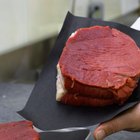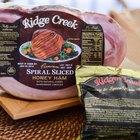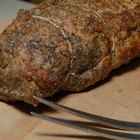
Bratwurst is a sausage that is German in origin, from the word brat (meaning finely chopped meat) and wurst (meaning sausage). Traditionally it is made from veal, pork, beef or a combination of those meats, although chicken, turkey and even vegetarian options are available. One variant is venison bratwurst. Because of its lower fat content, venison is often mixed with another meat, such as pork, when used in a sausage recipe.
Soak casings in water for at least two hours. After soaking, rinse them by placing one end of the casing over the tap and allowing the water to run through.
Mix together the salt, sugar, caraway seed, ground sage, ground allspice, marjoram and pepper in one bowl and set aside.
Combine the ground pork, ground beef, onion and beer in a large bowl. Mix by hand until all ingredients are thoroughly combined.
Add the dry seasonings to the meat mixture slowly, making sure they are completely mixed in.
Place one end of a casing over the stuffing tube of the grinder and hold it there. Add meat to the grinder and turn it on. When the stuffing tube fills with air, turn off the grinder and squeeze the air out of the casing. Tie it off at the end.
Push the meat steadily through the grinder, allowing it to fill the casing. When the casing is filled, tie it off and repeat the steps until all the meat is gone.
Related Articles
How to Stuff Edible Collagen Casings

Shank Ham Cooking Directions

How to Cook Chorizo in the Oven

How to Make a Juicy Pork Tenderloin

How to Make Dried Meat

Types of Portuguese Sausage

How to Marinate a Top Round Roast

How to Smoke Sausage in a Meat Smoker

How to Do Corned Pork

How to Cook Dominican-Style Steak

How to Marinate Meat With a FoodSaver

How to Cook Pork Hamonado

How to Make Sausage Links Without Casing

How to Smoke a Ham Shank on a Charcoal ...

Cooking Instructions for a Ridge Creek ...

How to Save Overcooked Pork

How to Cook a Large Amount of Corned ...

How to Make Jalapeno Beef Jerky

How to Cook Boneless Country Spare Ribs

How to Cook Shredded Pork in a Pressure ...
Writer Bio
Jacqui Lane has been writing professionally for print and the web since 2004. She got her start at a small publisher, where she wrote, edited, designed advertising and handled page layout for up to five magazines a month. She writes primarily about video games, technology and internet culture. Lane holds a Bachelor of Arts in online journalism from Marshall University.